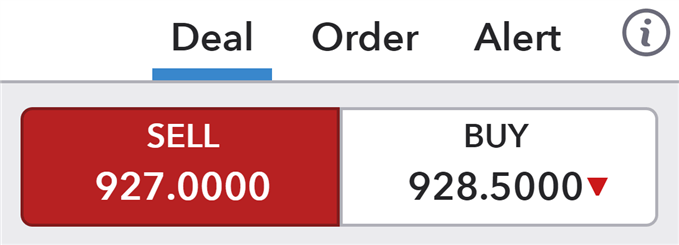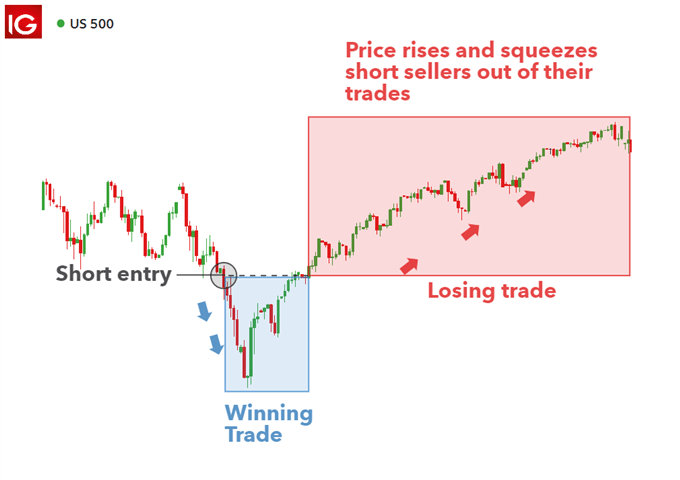How to Short Sell a Stock When Trading Falling Markets
Shorting a stock involves selling a borrowed stock in the anticipation of buying the same stock back at a lower future price and pocketing the difference. Short selling is a normal part of an active trader’s plan as it presents traders with the ability to benefit from an advancing market and a declining one. This article makes use of examples to explain what short selling is, why it is important and lists the top things to consider when short selling stocks.

WHAT IS SHORT SELLING AND WHY DO IT?
Short selling is the process of borrowing shares via a broker, selling those shares at the current market price and later buying the shares back at a lower price in order to return the shares to the broker.
Why short stocks? The answer to this question is multi-layered but in general, shorting stocks presents an opportunity trade a decline in a share’s price.
To some, short selling seems rather unethical because you are essentially taking a stance that a company’s share price will fall, which could result in large scale retrenchments affecting many households in the process. To others, this represents an opportunity to speculate in on over-valued stocks or to benefit from the largescale selling of unscrupulous companies.
Nowadays, in addition to retail traders, there are well-established hedge funds that focus on short selling, or ‘shorting’ various companies. Some short sellers publish research on companies that are alleged to have reported misleading figures in the publication of financial statements or where there is sufficient evidence of corrupt business practices.
Before diving into the world of short selling, we recommend you review the stock market basics.
WHAT DOES SHORTING A STOCK INVOLVE?
At this stage it may be helpful to differentiate between short selling stocks in the underlying market (non-leveraged) and shorting (selling or taking a short position) via a broker offering leverage.
The traditional approach has been set out above, where the short seller borrows shares from a broker, sells the shares and later buys the shares back at a discount to return to the broker.
However, the emergence of leverage trading has simplified this process to the point where shorting a stock is simply a matter of clicking the ‘sell’ button for the desired stock on an online platform.
Shorting a stock in this way involves:
- A regulated broker: It is crucial to trade with a regulated broker offering little to no leverage.
- Liquidity/Borrow: In order to short a stock, the broker must have sufficient ‘borrow’. Borrow refers to having a pool of liquidity providers willing to lend the necessary shares to the broker for its internal hedging requirements. In the absence of borrow, brokers can no longer facilitate short selling and will disable the short selling function until sufficient borrow returns to the market. More liquid stocks tend to provide greater borrow than illiquid stocks.
- Set risk parameters: When there is sufficient borrow, carry out the necessary analysis, set stops and limits and hit the ‘sell’ button on the online platform.
HOW TO SHORT SELL A STOCK
The following steps can be followed when shorting a stock:
- Select the desired market
- Confirm a down-trending market
- Predetermine stop losses and limits (risk-to-reward ratio)
- Enter the short trade
- The trade is complete once the stop or limit is hit
Traders can make use of the 200-day moving average or use trend lines to evaluate whether the stock is in a trending environment.
The short selling process can be made clearer by using actual figures in the form of a practical example.
SHORT SELLING EXAMPLE
Let’s say a short seller wishes to sell 10 shares of Apple Inc as he believes the share price is going to drop in the near future. If the price of Apple is $200 and the margin requirement is 50%, that means the trader would effectively be controlling $2000 ($200 x 10 shares) worth of Apple shares while only putting up $1000 ($2000 x 0.5) as margin.
The short seller sets the target at a price of $170 and a stop at $210 to establish a 1:3 risk-to-reward ratio. If price hits the target, the short seller could gain near $300 ($30 x 10 shares), minus any financing fees and commissions.
Nominal trade value = $2000
Margin = 50% ($1000)
Gain after taking profit = $300 ($30 x 10 shares)
Potential loss: $100 ($10 x 10 shares)
This example also presents the ideal scenario but financial markets are often unpredictable and do not move as reliably as presented here. It is for this reason that traders should adopt sound risk management practices from the outset.
WHAT ARE THE RISKS WHEN SHORT SELLING STOCKS?
When learning how to short sell stocks it is crucial to keep the following in mind:
- Potential for unlimited losses -Short positions without stops, theoretically have the potential for unlimited losses. There is no limit to the price of a share can rise to which further underscores the importance of stops.
- Short squeeze –A short squeeze occurs when short traders witness a rise in price (contrary to what was expected) leading to losses that eventually force traders to buy (to close the trade) at a higher price and take a loss. Price gains more upward momentum as more short sellers buy to close their positions.
Below is an example of a short squeeze using the US 500 (S&P 500):
- Unborrowable stock – In plummeting markets, even the most liquid shares can become unborrowable and therefore, prevent the opening of any new short positions. Traders need to keep this in mind but should also not allow this to force them into a rushed entry.
SHORT SELLING STOCKS: KEY TAKEAWAYS
Shorting a stock has been made a lot easier with the advancements in technology and forms a part of a trader’s skillset. However, unlike the forex market, stock traders are faced with the unique problem of unborrowable stocks that prohibit any shorting of stocks. Traders should only consider initiating a short trade after conducting the necessary technical and/or fundamental analysis while adhering to sound risk management practices.
As a reminder, the top 5 takeaways for shorting a stock are:
- Use a regulated broker: Consider using a highly regulated, reputable broker when short selling stocks.
- Trend: In the absence of a well-established downtrend, traders should set entry orders at favorable levels in the event the market gets there. Shares have the potential to trading gap down – especially if negative information finds its way into the public domain. In such fast-moving markets, traders can miss a favorable entry when away from the trading screen and orders can help.
- Liquidity/Borrow: Is the stock trading on a major exchange with a healthy number of shares changing hands daily, otherwise known as ‘free-float’? Greater liquidity tends to translate into more borrow being made available to short sellers and greater flexibility to short the stock.
- Borrow charge: In addition to any overnight funding charges on open positions held overnight, there are often ‘borrow charges’ that apply to short positions to allow short sellers to participate in the market. It is always a good idea to enquire about such a charge with your broker before placing a trade.
- Risk Management: Since short trades theoretically have unlimited losses with limited gain (price can only drop to 0), traders need to make use of stops and limits to rectify an inherently skewed risk-reward payoff.
SHORT SELLING STOCKS FAQS
What are the top stocks to short?
Stocks that become attractive to short sellers vary by industry and sector. Therefore, there is no single stock that traders should target for a short trade. Short sellers apply a number of analysis techniques - mainly fundamental in nature - looking at revenue and debt to equity ratios but also looks at other aspects of the business like the corporate governance structure and caliber of senior management.
All the major stock indices can be viewed on our major stock indices page.
How long can you short a stock?
There is no limit to the length of time traders can hold long positions. This is because shares are owned outright and do not involve borrowing someone else’s shares. Shorting stocks on the other hand involves borrowing shares that can be recalled by the broker at any time. There is no set length of time that traders will typically be able to hold a short trade and this will depend entirely on the market conditions at the time and when the owner of the shares wishes to liquidate those very shares.
Article by Richard Snow, Markets Writer, 16th July 2021. DailyFX
-
 1
1







.jpeg.98f0cfe51803b4af23bc6b06b29ba6ff.jpeg)
0 Comments
Recommended Comments
There are no comments to display.
Create an account or sign in to comment
You need to be a member in order to leave a comment
Create an account
Sign up for a new account in our community. It's easy!
Register a new accountSign in
Already have an account? Sign in here.
Sign In Now